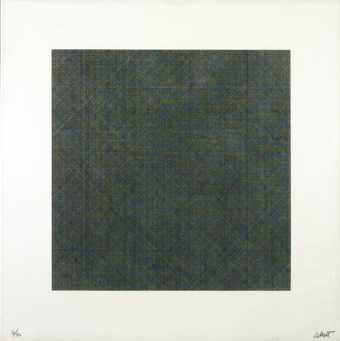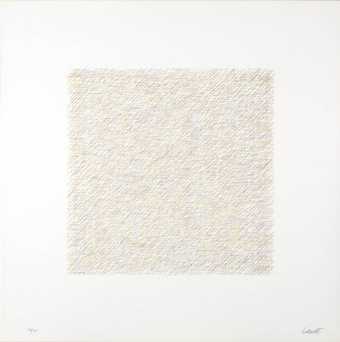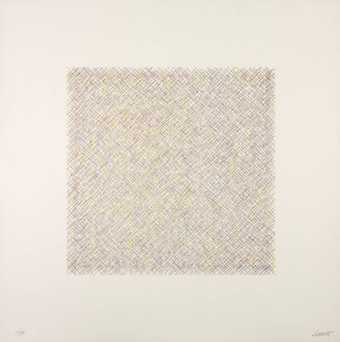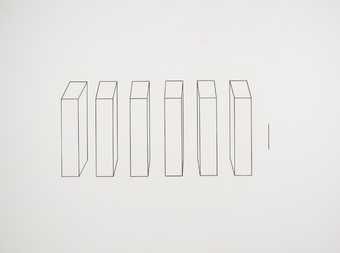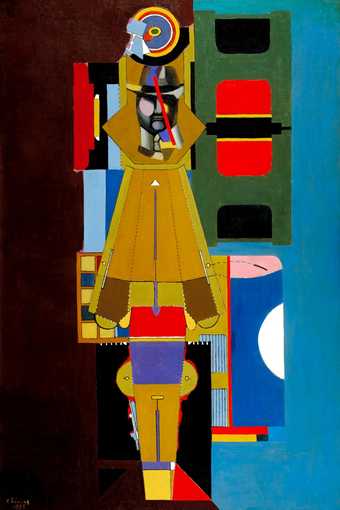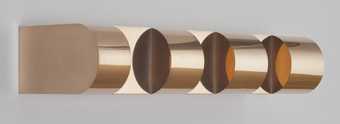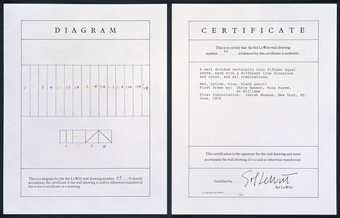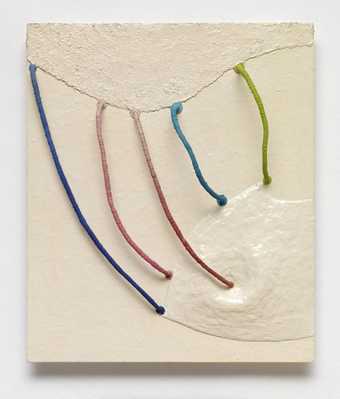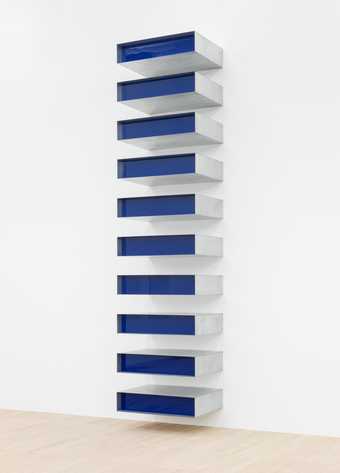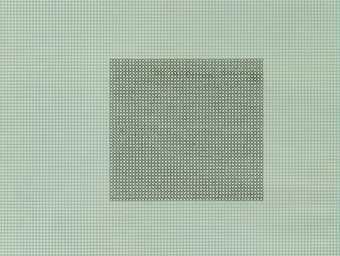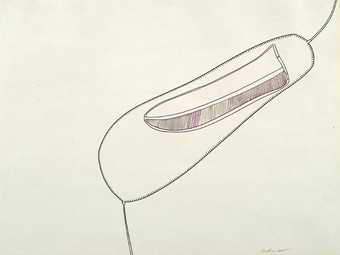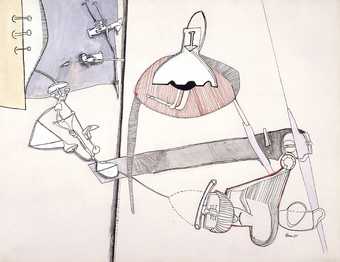
Not on display
- Artist
- Eva Hesse 1936–1970
- Medium
- Papier mâché, wood and cord
- Dimensions
- Object: 124 × 3029 × 206 mm
- Collection
- Tate
- Acquisition
- Purchased 1979
- Reference
- T02394
Summary
Addendum is a large sculptural wall installation by the German-born American artist Eva Hesse. Seventeen light grey papier mâché hemispheres are systematically arranged at increasing intervals on a wooden bar coated in the same material. Long pieces of painted rope issue from the centre of each hemisphere and fall to the ground, coiling in unpredictable loops. The horizontal, organised rhythm of the bar and hemispheres contrasts with the vertical cascade of the cords. The hemispheres are textured and the paint on them has become cracked and discoloured. Due to the contrast between the organic-looking hemispheres and the manufactured rope, the sculpture seems to represent a mixture of natural and manmade forms. The size and height of the sculpture, coupled with the chaotic coils entering the viewing space, give this sculpture an imposing presence.
Addendum was made in 1967, when the artist was living and working in a studio loft at 134 Bowery, New York. The textured, uneven surfaces of the bar and hemispheres reveal the addition of multiple layers of pulp. No attempt has been made to smooth these over or hide the process of making, and this becomes an important part of the composition. This practice of revealing the handmade elements of the work is a feature of Hesse’s practice (see, for instance, Sans III 1969, Galerie Hauser and Wirth, Zurich).
An undated work on paper named Untitled (Allen Memorial Art Museum, Oberlin College, Ohio, reproduced in Sussman 2002, p.33) could suggest a genesis for Addendum. This typed and handwritten list features words and their definitions, including ‘Addendum – A thing added or to be added’. Above these words Hesse has drawn what looks like a stylised version of Addendum. Curator Elizabeth Sussman has suggested that these definitions may have come from a thesaurus Hesse had been given by her friend, the artist Mel Bochner (Sussman 2002, p.32). However, in 1967 Hesse has stated that ‘the title of this work is Addendum, a thing added or to be added. A title is after the fact. It is titled only because that is preferred to untitled. Explanations are also after the fact. The work exists only for itself. The work must contain its own import’ (quoted in The Tate Gallery 1978–80: Illustrated Catalogue of Acquisitions, London 1981, http://www.tate.org.uk/art/artworks/hesse-addendum-t02394/text-catalogue-entry, accessed 20 May 2016).
Addendum was created for the Art in Series exhibition held at Finch College, New York, which opened in November 1967. Sussman has described how Hesse’s experimentation with seriality, begun in 1965, was ‘pushed’ by Addendum, which was exhibited alongside ‘rigorously serial works’ by artists such as Sol LeWitt, Donald Judd and Robert Smithson (Sussman 2002, p.208). In 1967 Hesse emphasised the mathematical genesis of this work: ‘the structure is five inches high, nine feet eleven inches long, and six inches deep. A series of seventeen, five inch diameter semi-spheres are placed at increased intervals. The interval progression is as follows: 1/8, 3/8, 5/8, 7/8, 1 1/8, 1 3/8, 1 5/8, 1 7/8 etc.’ (Quoted in Scott Rothkopf, ‘Seriality and Addendum’, in Sussman 2002, pp.207–8, p.208.)
Unusually, Hesse completed a large-scale drawing for Addendum in 1967 (private collection), most likely in order to help scale up the precise measurements required. She also stressed the inherent disorder in Addendum in 1967: ‘the cord opposes the regularity. When it reaches the floor it curls and sits irregularly. The juxtaposition and actual connecting cord realises the contradiction of the rational series of semi-spheres and irrational flow of lines on the floor. Series, serial, serial art, is another way of repeating absurdity’ (quoted in Sussman 2002, p.27). Hesse’s dichotomous engagement with order and delight in the ‘absurdity’ of serial art sets her apart from her colleagues, especially Judd.
Curator Scott Rothkopf has noted that after Addendum, Hesse ‘retreated from this brand of mathematically predetermined seriality, making Addendum not only her greatest statement in this mode, but her last’ (Rothkopf 2002, pp.207–8, p.208). From 1965 Hesse’s sculptures and works on paper became increasingly monochrome and form was allowed to predominate (see, for instance, Untitled 1967, Tate T04151). Hesse has been widely linked with minimalism, as well as to the work of Louise Bourgeois in her use of organic handmade forms.
Further reading
Renate Puvogel, ‘Eva Hesse: New Ground in Sculpture’, Forum International, vol.4, no.17, March–April 1993, reproduced p.86.
Elizabeth Sussman (ed.), Eva Hesse, exhibition catalogue, San Francisco Museum of Modern Art, New Haven 2002, reproduced pp.27 and 210–11.
Vanessa Corby, Eva Hesse: Longing, Belonging and Displacement, London 2010, reproduced p.107.
Jo Kear
May 2016
Supported by the Terra Foundation for American Art.
Does this text contain inaccurate information or language that you feel we should improve or change? We would like to hear from you.
Display caption
The hemispheres along the bar of Eva Hesse’s Addendum are positioned at increasing intervals determined by a fixed mathematical series. Many artists used serial systems at this time because they provided a way of composing sculptures without recourse to personal expression. Hesse hung rope cords from each hemisphere which fall to the ground in unpredictable curls. The regulated structure of the bar contrasts with the disordered appearance of the cords. But Hesse recognised that such systems were hardly rational, commenting that ‘Serial art is another way of repeating absurdity’.
Gallery label, October 2016
Does this text contain inaccurate information or language that you feel we should improve or change? We would like to hear from you.
Catalogue entry
T02394 ADDENDUM 1967
Not inscribed
Painted papier mâché, wood and cord, 4 7/8 × 119 1/4 × 5 7/8 (8 1/8 at deepest point) (12.5 × 304.5 × 15 (20.5) without cords; length of cords approx. 118 1/8 (300)
Purchased from Victor Ganz (Grant-in-Aid) 1979
Prov: Purchased by Victor Ganz from the Fourcade Droll Gallery, New York 1972
Exh: Art in Series, Finch College Museum of Art, Contemporary Wing, New York, November 1967–January 1968 (no catalogue, tape recording by participating artists); Eva Hesse A Memorial Exhibition, Guggenheim Museum, New York, December 1972–February 1973, Albright-Knox Art Gallery, Buffalo, March–April 1973, Museum of Contemporary Art, Chicago, May–July 1973, Pasadena Museum of Modern Art, September–November 1973, University Art Museum, Berkeley, December 1973–February 1974 (18, repr.pl.18); Eva Hesse 1936–1970: Sculpture, Whitechapel Art Gallery, May–June 1979, Rijksmuseum Kröller-Müller, Otterlo, June–August 1979 (25, repr. 16, n.p.); Eva Hesse 1936–1970: Skulpturen und Zeichnungen, Kestner-Gesellschaft, Hanover, August–September 1979 (25, repr. fig. 25 pp.20 and 48)
Lit: Lucy Lippard, ‘Eva Hesse: The Circle’, From the Centre, New York 1976, p.159 (reprinted from Art in America, LIX, no.3, May–June 1971); Lucy Lippard, Eva Hesse, New York 1976, statement by the artist p.96, pp.192, 216 (n.17), 59 in catalogue raisonné of sculpture, repr. fig.129, pp.94–5; artist's statement reprinted Eva Hesse 1936–1970: Sculpture, Whitechapel Art Gallery and Eva Hesse 1936–1970 Skulpturen und Zeichnungen, Kestner-Gesellschaft, Hanover (op. cit.); Andrea Hill, ‘Eva Hesse’, Artscribe 18, p.42, repr. p.43
Repr: Mel Bochner ‘The Serial Attitude’, Artforum, VI, December 1967, p.33 (as ‘Untitled’ 1967); David Lee, ‘Serial Rights’, Art News, LXVI, no.8, December 1967, p.44
This was Hesse's major piece for 1967, a year described by Lucy Lippard as ‘... the most geometric, serial and Minimal’ of the artist's career. On her return to New York from Germany in 1965 Hesse began to simplify the forms in her sculpture, placing formalized versions of the elements she had used in the German reliefs within a more geometric framework. She re-adopted her more sombre palette of the early sixties and began to work increasingly in monochrome. This clearer and more structural approach was, in part, a response to the prevailing climate in New York at the time; the new Minimal works of Sol LeWitt, who had been a friend since 1960 and who was to be one of the strongest supporters of her work, were a particular influence. Other artists important to her development at that time were Mel Bochner, Robert Ryman, and Carl Andre.
The earliest piece to incorporate a rectangular support, hemispheres and dangling cords was ‘Ishtar’ (repr. Lippard fig.70), completed in December 1965. This is a vertical relief bearing a series of twenty hemispheres, arranged two-by-two. A cord falls from the centre of each dome and these accumulate in two cascades at the bottom of the piece. The idea was further explored in ‘Ennead’ (repr. Lippard fig. 80), probably completed after March 1966, where the symmetry of a grid of smaller raised hemispheres is again deliberately counteracted by emergent strings, which, this time, drop to the floor in a tangled mass. In the middle of 1966, Hesse's drawings, hitherto more organic, began to reflect her new preoccupation with structure and she applied the grid format to a series of delicate ink and wash drawings of circles or targets. However, these were not working drawings for sculptures and Lippard notes that Hesse was never at ease with mechanical or scale drawings, ‘Bochner and Le Witt showed Hesse how to make a ‘working drawing’, but difficulties with scaling led her to make the one for Addendum full scale’ (note 17, op.cit.). This drawing executed on plain white paper, is currently on loan from a private collection in New York to the Wadsworth Atheneum, Hartford, Connecticut.
Three further wall pieces directly related to T02394 are ‘Untitled’ (1966), ‘One More Than One’ (1967) and ‘Ditto’ (1967) (Lippard figs. 114–116). The first consists of a rectangular framework containing a single convex dome which is linked to the floor by a rubber tube issuing from its centre. In ‘One More Than One’, two plastic cords hang from a pair of roughly textured concave half-circles or inverted ‘breasts’ and in ‘Ditto’, which resembles both Hesse's drawings of the period and the earlier ‘Ishtar’, cords dangle from a series of nine flatter textured circles, arranged in lines of three within a smooth rectangle. The exhibition, Art in Series, at Finch College Museum in New York where ‘Addendum’ was first shown was jointly organized by Elayne Varian and Mel Bochner. All works in the exhibition were based on arithmetical or serial progressions and among other artists who participated were, Donald Judd, Dan Flavin, Sol LeWitt, Robert Smithson, Elsworth Kelly, Jasper Johns and Robert Rauschenberg. Bochner chose T.2394 as one of the illustrations for his key article, The Serial Attitude (loc. cit.) which discussed the theme of the exhibition. However, despite Hesse's interest in serial concepts, her work always veered towards the expressive and ‘Addendum’, although one of her more ‘minimal’ works, retains an organic informality which sets it apart from the austere and economic works of some of her co-exhibitors. Reviewing the exhibition in the Village Voice (‘Repeating Absurdity’, December 14, 1967, p.18), John Perreault commented on the restrictions of working within a tight arithmetical format. ‘Only one artist in the show, Eva Hesse, in a piece called “Addendum” -a grey structure containing a serial arrangement of semi-spheres out of which hang lengths of grey cord that fall to the floor and get all tangled up in each other - sees, questions, and in a way relishes the absurd implications of this new cliche.’
There was no catalogue for the exhibition but the participating artists made Acoustiguide recordings explaining their work. Hesse stated: ‘The title of this work is Addendum, a thing added or to be added. A title is after the fact. It is titled only because that is preferred to untitled. Explanations are also after the fact. The work exists only for itself. The work must contain its own import.’ She went on to describe the structure of T02394, giving basic dimensions and explaining the placement of the seventeen hemispheres, which are based on the following interval progression; 1/8, 3/8, 5/8, 7/8, 1 1/8, 1 3/8, 1 5/8, 1 7/8, etc. She said that she chose three discrete units, rope, rectangle, hemisphere, (‘as different in shape as possible’) and set about unifying them through sequential placement, the device of repetition and the unified textured grey of the surface. This reconciliation of opposites is deliberately unbalanced by the artist's specification that the work is to be hung seven feet from the floor, so that the flexible cords start their downward journey in parallel lines but, because of their length, collapse in a random mass at ground level. The artist concluded her statement, ‘Series, serial, serial art, is another way of repeating absurdity.’ (This sentence repeated several times was originally to have been her only comment on the work.) In one of a series of interviews with Cindy Nemser given towards the end of her life, (Cindy Nemser, ‘Art Talk: Conversations with 12 Women Artists’, New York 1975, pp.209–10) Hesse commented in reference to ‘Ennead’, on her earlier use of a circular motif; ‘I think the circle is very abstract. I could make up stories of what the circle means to men, but I don't know if it is that conscious. I think it was a form, a vehicle. I don't think I had a sexual, anthropomorphic or geometric meaning: It wasn't a breast and it wasn't a circle representing life and eternity. I think it would be fake -maybe on an unconscious level, but that's so opposed - to say it was an abstract life symbol or a geometric theory ... One memory I have: I remember always working with contradictions and contradictory forms which is my idea also in life. The whole absurdity of life, everything for me has always been opposite ... And I think, I know that, in forms I use in my work, that contradiction is certainly there. When I was younger...I was always aware that I could combine order and chaos, string and mass, huge and small. I would try to find the most absurd opposites or extreme opposites and I was always aware of their contradiction formally ... within the circle I remember taking this straight perfect form and then putting a hole in the centre and dropping out a very ... flexible surgical hose ...I would make it very ...long and then it would squiggle and wiggle. That was the extreme you could get from that perfect, perfect circle.’ Asked about her repetitive use of forms, she replied ‘If something is meaningful, maybe it's more meaningful said ten times. It's not just an aesthetic choice. If something is absurd, it's much more greatly exaggerated, absurd, if it's repeated.’
Published in:
The Tate Gallery 1978-80: Illustrated Catalogue of Acquisitions, London 1981
Explore
- abstraction(8,615)
-
- from recognisable sources(3,634)
-
- figure(2,270)
- non-representational(6,161)
-
- geometric(3,072)
- irregular forms(2,007)
- formal qualities(12,454)
-
- order(41)
- repetition(391)
- sequence(156)
- illogicality(17)
You might like
-
Sol LeWitt [no title]
1971 -
Sol LeWitt [no title]
1971 -
Sol LeWitt [no title]
1971 -
Sol LeWitt [no title]
1971 -
Sol LeWitt [no title]
1973 -
Sol LeWitt Untitled
1971 -
Donald Judd [no title]
1988 -
Richard Lindner Stranger No. 2
1958 -
Donald Judd Untitled
1973 -
Eva Hesse Tomorrow’s Apples (5 in White)
1965 -
Donald Judd Untitled
1980 -
Eva Hesse Untitled
1967 -
Eva Hesse Untitled
1965 -
Eva Hesse Untitled
1965

